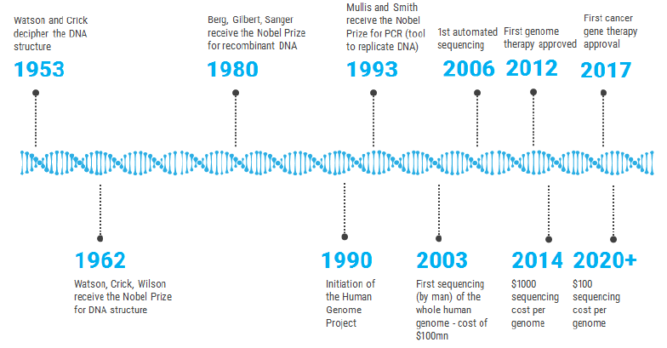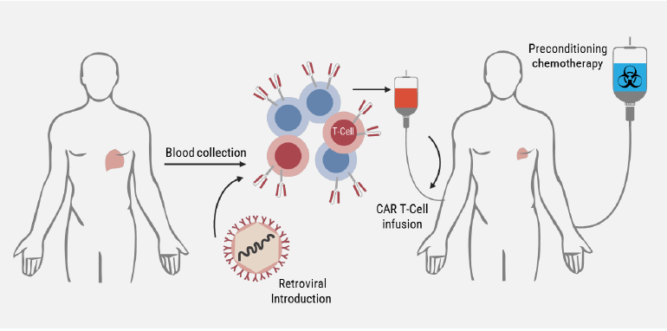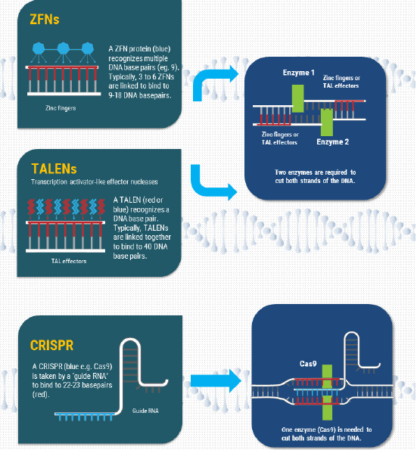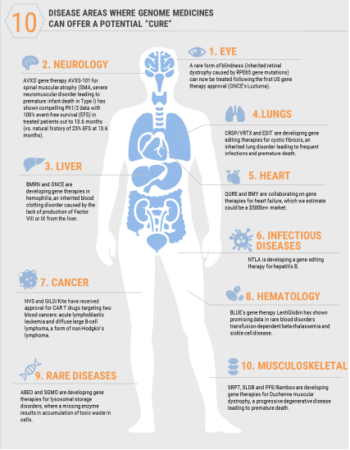The first thing that comes to mind when we hear about the genome medicine is GMO (genetically engineered foods), people with supernatural powers, and crowds of zombies going on the streets. For unknown reasons, people skip the “medicine” part and turn the full meaning of the term upside down. Speaking seriously, genome medicine is nowadays considered to become one of the most significant breakthroughs of our era.
Medicine of 21st century doesn’t stand still and continues to surprise us with new inventions and technologies. All the efforts are aimed at improving our longevity, wellness, and helping us to live better in general. Diseases that have never been treated before are not our fate anymore for today. They have high chances of being cured by using the technologies that were not known have previously. But it is not enough. It is never good not enough for people that is the primary driver of our development. We always want more, it doesn’t matter in which industry, and this is the main thing that “pushes” us forward and inspires on breakthroughs.
Genome medicine is one of the greatest revolutions in the healthcare industry for today. The newest technologies, attractive forecasts and positive results in researches are the main reasons for investors from all over the globe to focus on this industry. The long-awaited science optimization together with the positive results in clinical trials has nowadays resulted in the gene/cell therapy entering the world with incredible speed. All this along with regulatory approvals contributes to the creation of entirely new markets that are ready to change modern medicine and start a revolution. Genome medicine revolution.
What Do You Promise Us, Genome Medicine?
There are three main drivers of the revolution in medicine and modern healthcare world:
- gene therapy;
- genetically-engineered cell therapy;
- gene editing.
All these inter-related technologies have a huge potential to create new profit pools and entirely disrupt the existing biopharmaceutical market. Managing and manipulating with genes, that are responsible for all the human attributes, starting from the eye and hair colors and finishing with the risk of developing rare diseases, have turned from something fantastic into reality. The discovery of the first gene editing system CRISPR/Cas9 has become the first step on the way to target the genetic cause of diseases. Genes replacing, editing or introducing the genetically-engineered cells may significantly transform the treatment of such disease categories as cancer, neurology, ophthalmology, liver, etc. The genome medicine represents for today a $4.8tn total addressable market (TAM) that is significant disruption for the whole biopharmaceutical industry with $1tn of annual sales.
However, we believe the genome medicine will develop not only to address the rare diseases that don’t have existing treatments or have just the limited ones but also to create the much larger markets for common diseases.
Off-the-Shelf Cell Therapy
How much do we know about the genes? We can get the simplest answer to the question what the genes represent by looking in the mirror. Everything that we will see represents a set of genes – our eyes, hair, skin colors and facial features. All of this and many more other features are the results of the unique genes pattern, DNA site that is “responsible” for us as we are today.
Gene therapy appeared in the 1970s as the opportunity to cope with the “dark side” of the genes pattern, namely, human genetic diseases. The first scientific research was devoted to the use of healthy DNA to replace defective DNA in patients who had different genetic disorders. It has been proven that the severity of genetic diseases directly depends on a number and a role of genes in the defective DNA site. The main disadvantage of genetic diseases is their comparably rare occurrence. They happen approximately only in 200k people in the US and only 1 case in 2k in Europe. For this reason, only a minority of all the genetic diseases have approved therapies. The earliest clinical studies that have been held in National Institute of Health were focused on delivering the functional copy of the gene into cells ex vivo by using a lentiviral approach and transferring the cells back into the body.
A great splash of the drug development in biotechnology has occurred after the Human Genome Project. It resulted in sequencing the human genome and gave scientists an opportunity to find out how the genetic targets cause diseases as well as identify new of them. In addition to this, the cost of sequencing the human genome has declined dramatically (to $1k from $1mn) that also accelerated the genome revolution development. All of this enabled drug developers to:
- identify the primary genetic targets to address the disease;
- develop animal models to find out what the clinical benefit will be for humans;
- identify biomarkers that serve as the early indicators of drug activity and safety.
These advances have contributed to higher standards of clinical safety and more rigorous regulatory oversight. They stimulated a re-emergence of efforts to develop safer and more effective genome therapy.
Now the following questions arise “what is the cell therapy?” and “what are the relations between this and the gene therapy?” Cell therapy is based on the ability of gene therapy to insert the necessary gene into a cell. It works on a cellular level to infuse modified, enhanced cells into the patient’s organism to fight disease. For example, in the case of cancer, engineered immune cells have made significant advances with CART and TCR cell therapies. There are four main steps in this mechanism work in case of cancer treatment:
- T cells from the patient are collected through a blood draw;
- The T cells are fitted with a CAR designed to hone in on targets on the surface of tumor cells;
- Engineered CART cells are inserted in the blood again;
- The CAR directs the cells to the tumor where they can release toxic chemicals and locally kill the cancer cells.
The Next Wave of Genome Medicine – DNA Editing
Gene editing is the next frontier in the genome medicine and can boast of astonishing results even on the stage of development. By the creation of gene editing it is possible nowadays to “cut” the DNA that allows several different types of edits to be accomplished. How does it work? Acting as the “molecular scissors,” engineered nucleases can be programmed to create super precise cut at any needed DNA site, thereby allowing scientists to edit the genetic blueprints of living cells.
What are the use cases for gene editing? Three main types of edits will become possible with this technology:
- Gene editing can be used to physically cut off (remove) the DNA fragment that is “responsible” for the disease occurrence.
- It can serve to repair disease-causing regions of DNA (in the case of inherited genetic disorders, the diseased DNA would be excised and replaced with the healthy DNA sequences).
- The engineered nucleases allow inserting a DNA fragment into a patient’s genome for achieving a therapeutic effect. This option includes the insertion of synthetic DNA fragments, such as those used in cellular immunotherapy treatments (CARTs).
The ability to correct DNA allows destroying the disease at its “root” by knocking out, repairing or replacing defective genes.
Conclusions and Highlights
Innovations in gene editing offer great potential to push forward the general progress of genome medicine. Next-generation technologies are just around the corner and all the companies, that innovate to advance them, are expected to gain a competitive advantage in the nearest future. The global TAM for genome medicine based on the newest generation of such technology platforms as gene therapy, gene editing, and cell therapy, is expected to reach $4.8tn that will be driven by oncology ($1tn), neurology ($1.5tn), and eye disorders ($0.5tn). The vast commercial opportunity becomes available, inspired by creation of new profit pools and global disruption of existing therapies (such as cancer, heart, neurology, and viral infections).
What are the main conclusions on the topic of genome medicine?
- Genome medicine technologies allow transforming the treatment of such disease categories as cancer, neurology, ophthalmology, and liver significantly;
- The genome medicine represents for today a $4.8tn total addressable market (TAM) that is a significant disruption for the whole biopharmaceutical industry with $1tn of annual sales;
- Genome medicine continues its growth with the DNA editing development;
- Not only rare diseases that don’t have existing treatments but also much larger markets for common diseases can be addressed with the genome medicine technologies.





Recent Comments